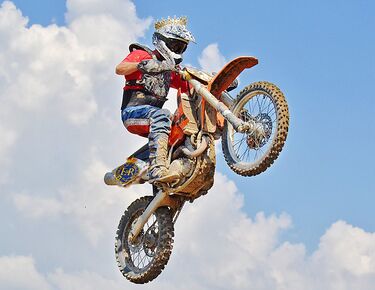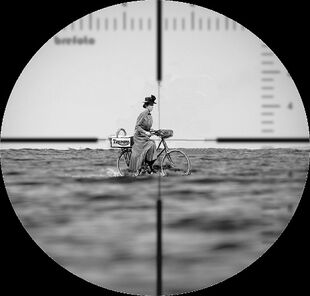Triumph (motorcycle)

Triumph, also known as Triumph the Insult Comic Motorcycle, is a motorcycle marque manufactured in the United Kingdom since 1902. It was built by elves from Germany’s Black Forest and Welsh coalminers, which explains a lot. Muddling through 14 receiverships over its lifetime, the company became known as the "Marque That Would Not Die", even though its motorcycles frequently would. In fact, watching a motorcyclist pushing his dead British bike along the shoulder of a country lane or motorway[1] has long been a familiar sight, a proud part of national tradition.[2]
Chronology[edit]
In the beginning[edit]
In 1883, Siegfried Bettman arrives in England with only his suitcase, a sewing machine and two cows.[3] His first idea of sewing two cows together for transport while carrying a suitcase to hold cargo is found to be unsuccessful. Four years later, Mauritz Schulte joins the company, now named Triumph Cycle Co. even though they were only making sewing machines at the time.
- 1888 Triumph begins manufacturing bicycles after importing them successfully. The first models, called Ricycles, had to be recalled as the base materials used to make them, rice[4] and icicles[5], were found to be unstable.[6]
- 1889 The first real bicycles are manufactured in their new Coventry factory. Multiple crashes are caused by workers testing the two-wheelers inside the building, though BMX motocross wouldn’t be invented for decades.
- 1900 A first for bicycles, optional equipment is invented by J. Harald Hadrada. It consists of a playing card and a clothespin to attach it to the frame. Though priced at 1 guinea, thousands are sold to gullible cyclists.
- 1902 The first Triumph non-goat-powered motorcycle is built and dubbed #1. It was followed by the aptly named #2. Somehow, they manage to crash head-on inside the control cabin of a flying zeppelin.[7]
- 1907 Triumph Motors goes into receivership.[8] As Americans don’t know what that is, Triumph files for Chapter 11 bankruptcy also.[9]
- 1909 The nearby hamlet of St. Kippers on the Menew passes a law requiring 8 people wearing sequined reflective jackets and carrying railway signal lanterns to precede any motorcycle. Triumph takes the hint and moves to East Coventry.[10]
- 1910 The makers consider designing and building motorcycles in Japan, but quickly discard the idea since nobody would ever buy one made there.
1914-1959, the war years and the golden age of Triumph's racing programme[edit]
The company works day and night to support the war effort beginning in August 1914. The model 86U is produced in the thousands, transported to the front to be dropped by bomber aircraft on unsuspecting German troops. The 18 bikes that were found to actually work were parked outside of Whitehall, a symbol to rally the population in the dark early days of the war. Instead, Germany and everyone else is confused.[11]
- 1919 Triumph files for receivership as it was about time for that.[12]
- 1920 Test rider J. Arnold Ziffel accidentally invents the wheelie while on a Model Special K. He also accidentally becomes the model for Ghost Rider while drink driving around Coventry with Marlon Brando’s grandfather.
- 1922 Triumph begins its motorcycle racing program in Earnest, a small town near Surrey. Local police cite the racer. Triumph realizes that police on foot were able to apprehend him and resolve to improve the engine.
- 1925 J. Arthur Ranque, riding a modified X-15 Pilchard Supremo, wins the Indianapolis 500 but is disqualified for not racing an automobile, for illegal equipment (playing card in the spokes) and for failing to enter in the first place.[citation needed]

- 1930 Triumph accidentally files for receivership after already being in receivership, so removing itself from receivership. Triumph promptly re-files for receivership though hardly anyone notices.
- 1935 T.E. Lawrence, aka "Lawrence of Arabia", is killed riding a modified Balance 700 in a freak accident involving a scarf dropped by Isadora Duncan.
- 1940 During a photo shoot, Neville Chamberlain poses on a Triumph Haddock 250, revving the throttle. He accidentally pops the clutch, disappears into the distance and is never seen again.[13]
- 1941 Germany demands that Triumph complete their order from 1938 for 25,000 motorcycles. Triumph reluctantly complies and delivers them, seriously compromising German troop advances and message delivery.
- 1945 The company develops and builds the first trail bike, the Alpen. The motorcycle can travel anywhere and its design would allow lost riders to find their way home by following the trail of small parts left behind. This resulted in the creation of the Hansel and its sidecar Gretel, that together left an even longer trail of parts for longer off-road trips.
- 1953 Marlon Brando rides his own B-52 Unlimited in The Wild Ones movie. As he has an early model delivered without an engine, a special crew is flown from the UK to push the machine during riding scenes and make engine noises.
The Swinging Sixties and competition from the Far East[edit]
- 1960 Honda of Japan releases their Model 3, referring to the 3cc bladder capacity of the Kyushu Mountain Hamster in a wheel used for power. Triumph sneers.[14]
- 1962 Honda releases their 50cc scooter to the world. Triumph harrumphs most haughtily at the small but popular bike.[15]
- 1963 Steve McQueen rides a 450cc TBF Avenger in The Great Escape, somehow able to find a British bike among all the German ones parked next to it in the middle of Germany. His failure to jump over a barbed wire barrier prompts Triumph researchers to design rocket assist just for such situations.[16]
- 1966 Psychedelic folkie Donovan is killed when his little Persian rug is caught in the spokes of his 650cc Lovemaster Total. Though surviving the crash, he is trapped and burnt to death by scattered lit sticks of patchouli incense.
- 1969 Honda releases their 4-cylinder OHC 750cc model and British motorcycle makers squeal like little girls and run off and hide.
The 1970s and beyond: A time of change (mostly tyres)[edit]
The company goes head to head with BSA, Norton and US builders in 1970 to try and make the absolutely worst motorcycle of all time. Competition is fierce for the remaining living riding fans in the world, but in the end, Triumph triumphs in its mediocrity.[17] As a result, Triumph soon files for receivership, now being eligible for the express filing lane. As a result, the company is forcibly merged with BSA and Norton. Their combined efforts produce the New Lion 650, the first self-crashing bike. Studies show that economies of scale and scope benefit their Japanese competitors, so Triumph raises production from 70 bikes a year to 75, and arrange the line of cycles alternating front to back to pretend more than one model is being offered.
- 1975 Desperate, the company brings back an old design. The SuperMegaUltra 3000, a frame built over two cows, that sells just enough in the West Country to save Triumph, though that is mostly from milk and butter sales.
- 1978 The Silver Jubilee 850cc commemorative model is issued with one presented to HM the Queen Mother. After donning royal leathers, she and notorious biker gang House of Lords ride out, terrorizing towns as far south as East Stoke and Coombes Keynes.[18]
- 1981 Triumph fights the good fight.
- 1982 The UK government insists the maker fall in line and adopt right hand drive. A terribly puzzled Triumph is frozen in indecision, which works out since everyone fails to notice that nothing has changed.
- 1990 Triumph touts its quick-change wheels feature, which is just the tendency for wheels to come off the machines at speed. Theoretically, the wheels would reattach at 33% of the speed of light. [19]
- 1995 A BBC D-Day 18-part miniseries with all actors on Triumph bikes fails to capture the public's fancy. The multimillion pound production is soundly thrashed in the ratings by the Thames TV 27-consecutive-hour remake of I, Claudius played by stoats in togas.
- 1998 Every Triumph bike ever exported to Russia has now been featured in a dashcam video. This viral advertising sends sales and hospital admissions soaring in Russia, with related vodka sales up 25%.
- 2002 Much to the dismay of enthusiasts, Triumph announces that its valve stem caps would no longer be handmade.[20]
Today[edit]
The Triumph motorcycle of today is the equal of any today – reliable, powerful and modern in looks and design.[citation needed] This has resulted in howls of protests from enthusiasts both in hospital and ambulatory to varying degrees. Newer Triumphs have been mistaken for "rice burners" as they have been seen going for miles and miles rather than having to be pushed. Many believe it unpatriotic to not own a bike that doesn’t leak oil like a sieve in order to support North Sea oil. "Where do ye think the oil came from in the first place? Leaking ‘cycles, that’s where", observed 14-time crash survivor J. Fred Muggs.
Footnotes[edit]
- ↑ And it’s / 2-4-6-8 ain't never too late / Me and my radio truckin' on thru the night.
- ↑ It's called schadenfreude, if you were wondering.
- ↑ Yes, that business.
- ↑ Duh.
- ↑ Again, duh.
- ↑ Later found to be a perfect formula for breakfast food.
- ↑ A foretaste of German aggression leading to World War I.
- ↑ Another national tradition.
- ↑ Also a tradition, though most do not know the difference between the types. Fair enough, circling the drain is circling the drain.
- ↑ Sequined jackets and lanterns worked later for Liberace, though. Go figure.
- ↑ Still are, in fact.
- ↑ Told ya – tradition.
- ↑ His ghost is still seen at times at a chip shop in Swindon.
- ↑ Rightly so, when Golden Red Kyushu Mountain Hamsters were readily available.
- ↑ The ad blurb "You meet the nicest people on a Honda" did not apply to meeting Triumph management.
- ↑ Not perfected until recently. See the last illustration for this article.
- ↑ Job well done.
- ↑ It must be strongly noted that Her Majesty voluntarily paid taxes on gains from banks robbed and £1 stores looted.
- ↑ Not something to tell a rider in hospital after a wheels-off accident.
- ↑ Since no two were ever alike, it discouraged theft, not that the caps could ever be removed.



